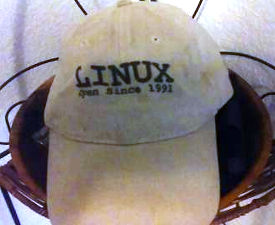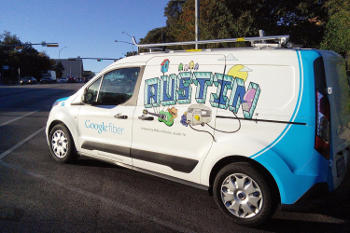“That hat’s going to get you labeled as a malcontent”.
I was standing in line at the local supermarket when a lady behind me expressed her opinion on my choice of head wear.
I turned and smiled. “Excuse me?”
She smiled and jerked her head up, glancing at the hat I was wearing. “Your Linux hat. That will probably land you on a no fly list. Maybe worse.”
 We had passed each other while shopping earlier and had exchanged nods and smiles. I had to laugh. She didn’t flinch when I put the robo-Ken device to my throat to talk to her.
We had passed each other while shopping earlier and had exchanged nods and smiles. I had to laugh. She didn’t flinch when I put the robo-Ken device to my throat to talk to her.
I waited for her to finish her bit in the checkout line and we walked out of the store together. We stopped short of the store’s outside roofed enclosure and ended up sitting on one of the benches.
Her name is Jaime and she’s an “asset manager” for a well-known tech company in Austin that makes, among other things, a mean Android phone from what I hear. She’s late thirty-something, single and a career driven person. Her work is primarily Linux and server-related, although she has a strong background in C++ and JavaScript. She has a masters degree in computer science and holds weekly programming classes for kids as part of her employer’s efforts to get young people interested in programming.
It didn’t take me long to ask the question I was wanting to ask, the moment she told me where she worked.
“What in the hell are you doing in Taylor, Texas?”
She smiled around the straw she was pulling on. She and her ex-domestic partner had bought a house here in Taylor four years ago because of the attractive buyer’s market and the relative ease the toll road provided in getting to work, but she would be leaving at the end of September. She had put her house up for sale and the paperwork would be done by that time. She had already secured an apartment in Southeast Austin.
I’ve lived in and around Austin for 25 years and I know the neighborhoods around the area. Up until four years ago it wasn’t the best side of town. The east side of IH35, off Oltorf and Riverside, was a hodgepodge of cheap apartments, mostly rented by University of Texas students. There was an abundance of dope dealers and it was the premier hub for Austin’s prostitutes. Not exactly the neighborhood I would choose to raise a family or even live as a single. In the past few years, the city has engaged in a number of projects to draw young professionals to the area, so it’s getting better, but still…
 She obviously saw my puzzled expression.
She obviously saw my puzzled expression.
“Google fiber,” she answered without my asking. “I’m moving there so I can get Google Fiber. The townhouse apartment complex where I will live offers it.”
When I asked if that was the only reason she was moving there, her answer was simple.
“Yes.”
Jaime went on to tell me that a number of her co-workers have already done the same. They have moved from outlying communities and areas such as Cedar Park and Leander. Her friends from places like Lakeway, Kyle, Elgin, Round Rock and Georgetown are either planning the same moves or have already moved into the first Google Fiberhoods. She guessed that 70 percent of them sold a home or will sell their home to facilitate the move.
When the first Google Fiber installation trucks rolled into Kansas City in 2011, Internet service providers like Time Warner and Comcast scrambled to stem the flow of customers already beginning to cancel business services. Google was offering absolute brother-in-law prices, and would even see if they couldn’t get businesses deals on new location rentals as well. Google had targeted businesses immediately upon their arrival to Kansas City, but it wasn’t only businesses that were jumping ship: 31 percent of polled Time Warner customers said they would switch to Google’s service as soon as it was available.
The bean counters at Time Warner and Comcast lost their friggin’ minds, not just in Kansas City but in Austin as well. Time Warner began rolling out plans that automatically doubled a residential customer’s speeds, with absolutely no cost to the consumer. Not only was Time Warner promising this in Austin, even little Podunk towns like Taylor, fifty miles away, were getting the deal.
Taylor is an “old” town, meaning that the average age of the Taylor resident is almost thirteen years higher than in most towns the same size. In other words, Time Warner was offering supercharged speeds, by their standards, to people who wouldn’t know or care about the difference even if you put it in a plastic bag with used kitty litter and hit them in the face with it. That’s how much Time Warner worried about losing customers.
I live in Taylor and I have to tell you that Time Warner did not screw around with this roll out. As soon as I heard of it, I called Time Warner and asked if it was true that their speed increase would include Taylor.
“Yes sir,” the customer service rep answered. “We will begin switching on your enhanced services in October.”
“Switching on” was an interesting turn of phrase. For years, Telecom and internet companies have been battling the “flipping the switch” myth that customers evoke when complaining about billing: “What the hell did you charge me a $30.00 connection fee for? All you have to do is flip a switch.”
 True to their word, on October 5, 2014, I was called by Time Warner to set up an appointment so they could have a technician stop by and install the new “managed Internet service” for our area. A few days later, a speed test from speedtest.net revealed an astounding differences. They had indeed “flipped the switch” in Taylor, Texas.
True to their word, on October 5, 2014, I was called by Time Warner to set up an appointment so they could have a technician stop by and install the new “managed Internet service” for our area. A few days later, a speed test from speedtest.net revealed an astounding differences. They had indeed “flipped the switch” in Taylor, Texas.
To be more honest than I probably should, I did fudge a little in order to get a download speed in excess of 300 Mbps. I had been receiving Time Warner service at 20 Mbps, but when I was sure we would be getting the speed increase, I ordered my service increased to 50 Mbps, the golden number for Time Warner to bump to the 300Mbps service we are now enjoying.
Enjoying? That’s a word I never expected to be attached to any conversation that included Time Warner.
But for Jaime, who had to fight Time Warner tooth and nail to get that service to her home in Taylor, it was too little, too late. Not only did they drag their feet on getting Jaime upgraded, everyone in her neighborhood faced the same problem. Something in the local Internet architecture wasn’t working or able to handle the increased speeds and Time Warner waited until the screaming had reached a crescendo before they did something about it. Jaime was not shy about telling me that she was largely responsible for Time Warner finally bringing the promised speeds to her neighborhood.
So, during the last weekend of September, Diane and I are invited to a house-freezing party, which will be Jaime’s way of saying goodbye to friends and neighbors. She told me there will be a few people from work who will be attending, and they are all deeply involved in open source projects in one form or another. A few of them are interested in talking with me. That, I am looking forward to.
Would I leave Taylor for Google Fiber? No…my home and work is in Taylor and I don’t see any reason for us to leave here. I am getting the speeds Time Warner promised while only paying for the 50 Mbps tier plan, so I cannot complain.
But in our last conversation, Jaime told me a total of nineteen people from her division at work are moving from outlying areas to get Google Fiber. She also noted that people from her group telecommute at least twice a week. That, in itself, is a good reason to get down with a Fiberhood.
I’ve got to wonder just how many people will follow Jaime’s and her co-workers’ lead and do the same. Apparently, it’s a lot. There isn’t much that would force Time Warner to give anything away for free. Not that I can think of anyway.
Help keep FOSS Force strong. If you like this article, become a subscriber.
Ken Starks is the founder of the Helios Project and Reglue, which for 20 years provided refurbished older computers running Linux to disadvantaged school kids, as well as providing digital help for senior citizens, in the Austin, Texas area. He was a columnist for FOSS Force from 2013-2016, and remains part of our family. Follow him on Twitter: @Reglue








I can’t wait for Google Fibre to come to the UK